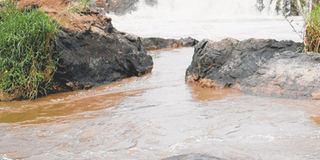A clever art in conservation

PHOTO I FILE
Ng’ang’a Mbugua’s book is a captivating tale about a waterfall threatened by a merchant who starts to mine building stones from around it.
It would appear that matters to do with environmental conservation occupy a special place in the world of Ng’ang’a Mbugua.
Since they fire his creativity, his last two books have all focused on environmental conservation as their central theme.
And while these issues might appear boring and the least likely subject of a novel, Mbugua has nevertheless breathed life into these otherwise mundane issues and crafted interesting stories around them.
Call him an NGO novelist, an environmental crusader/activist, and any other such names but the fact of the matter is that Mbugua’s books are immensely readable.
This is a refreshing departure in an environment where captivating Kenyan writers are few and far between.
Mbugua’s foray into ‘‘environmental writing’’ started with his book Susana the Brave, a primary school reader that talked about a teacher who, after being posted to a school in an arid area, went ahead and transformed the place due to her dedicated campaign to plant trees.
His second book Terrorists of the Aberdare addressed the delicate issue of human-wildlife conflict and by extent, forest conservation.
And, for his troubles, Terrorists of the Aberdare won the third edition of the Wahome Mutahi Literary Prize.
His latest book, Different Colours, and which I think is his most ambitious, has taken the game a notch higher. Not only has he written on his pet subject, he has fused it with the sublime world of art.
In this book, Mbugua has directed his ‘‘activism’’ to an imaginary waterfall in an equally imaginary Banana County, which is
threatened by an unscrupulous merchant who starts to mine building stones from around the waterfall. The hero of the book is
Miguel, a dreadlocked artist – don’t they all sport dreadlocks? – who after hearing of the beauty of the waterfall decides that he must
immortalise it on canvas.
It is while on one of his surveying missions that he accidentally bumps into a group of men hard at work in a secret quarry.
The story unfolds after the owner of the secret quarry is alerted of Miguel’s nosiness.
Not that Dik Teita (note the play on the word dictator) hadn’t had his fears as to the intentions of the newly arrived ‘‘rastaman’’.
The moment he got wind of Miguel’s mission of painting the waterfall – word travels fast in Banana – he feared it was a matter of time before his secret quarry was discovered.
To prevent this Dik Teita comes up with what he thinks is a convenient smokescreen: make Miguel paint the local cattle dip.
Seeing that the cattle dip ruse didn’t work, Dik Teita resorts to intimidation and threats of violence.
And who better does this dirty work than Vu Tabangi (bhang smoker), the village thug. Sadly for Dik Teita, the threats have the opposite effect on Miguel: his resolve to save the waterfall from destruction hardens.
Together with Angela, his landlady, they mobilise the local community on the importance of conserving the waterfall, which is their lifeline. They also enlist the services of Derek, Miguel’s friend, who is also a tech geek.
Derek also has contacts in media. Operation Save Waterfall has started in earnest.
Meanwhile, the noose tightens on Dik Teita and his goons. It also emerges that Dik Teita was behind the death of Angela’s husband.
Despite numerous false starts, Miguel is finally able to finish his painting.
While the waterfall conservation saga is engrossing I found the parts dealing with Miguel’s art most appealing.
It is either that the author is an accomplished art connoisseur or that he had done his homework on all that entails art, paintings and other forms of visual art.
Whatever the case, the informed discourse on art really uplifts Mbugua’s book.



